Łask 2012-06-21
Łask military airport.
Geographic coordinates: 51.551N 19.181E. Elevation 193 m.
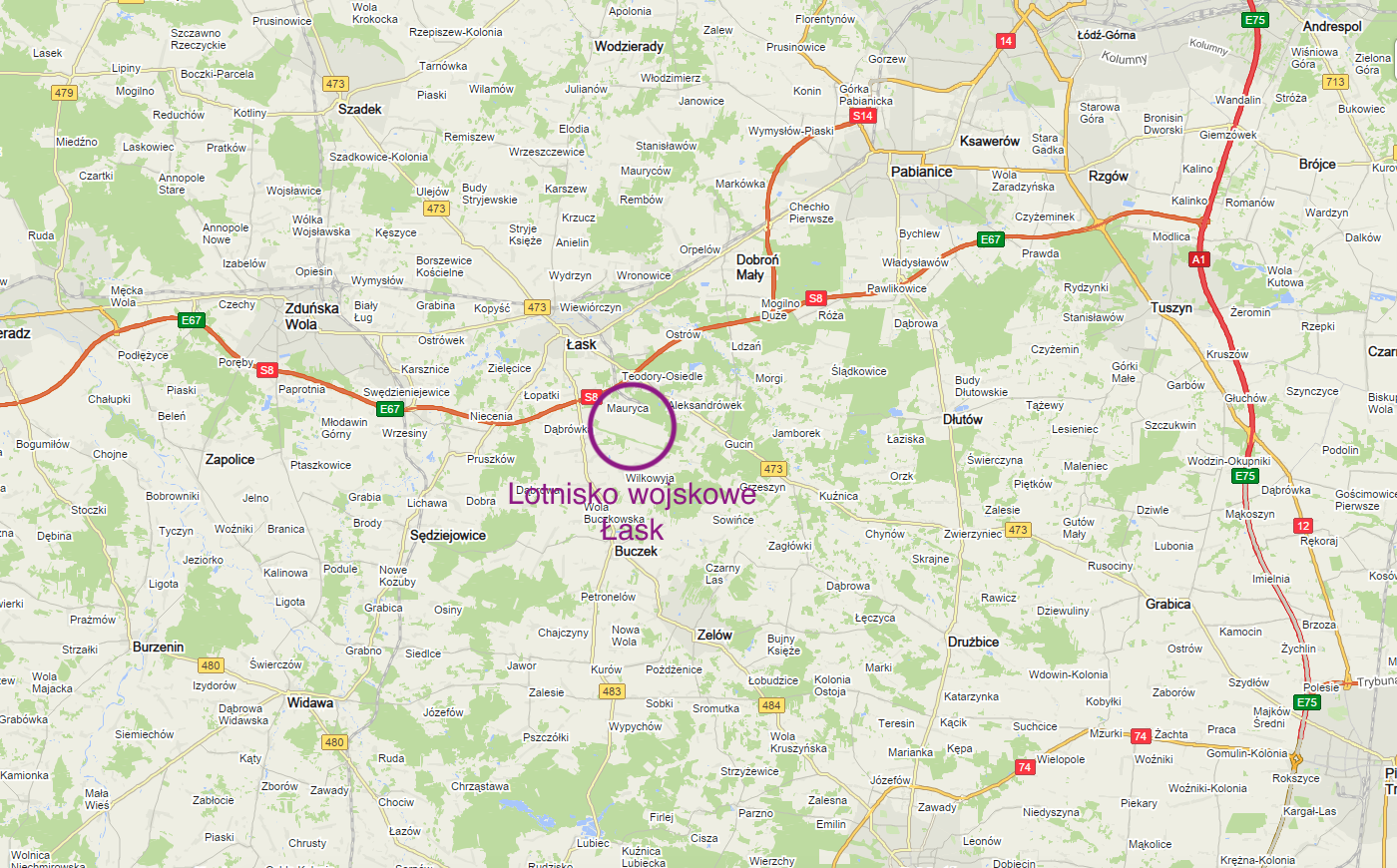
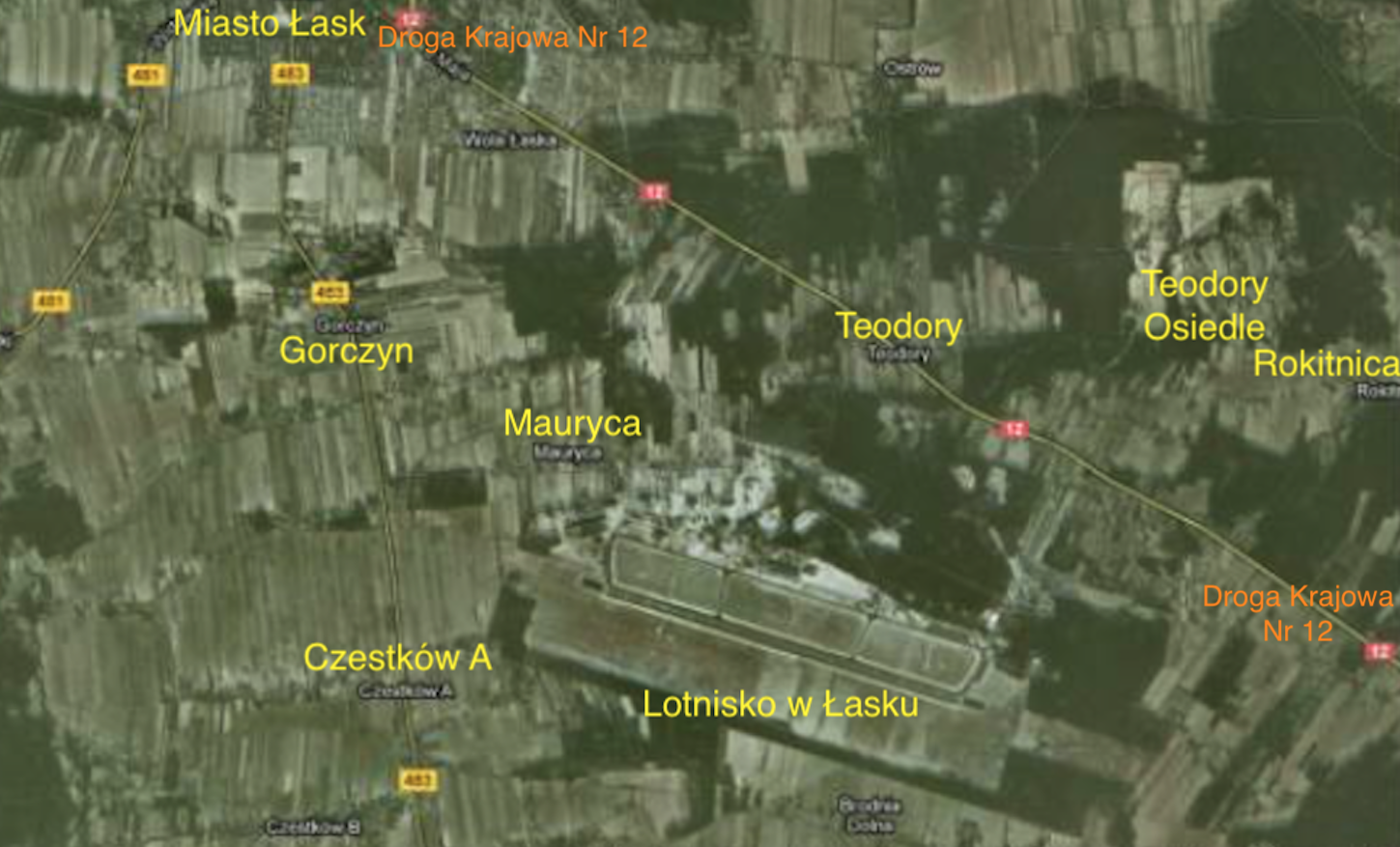
Łask airport - location.
The airport is located about 5 km south-east of Łask. It is situated between roads No. 44 and No. 483 in the village of Brodnica. Geographical coordinates 51.33 N, 19.10 E, at an altitude of 193 m above sea level. It has a runway with a concrete surface, dimensions 2,500 m x 60 m, with an orientation of 11/29. Throughout its history, the airport served as a military airport.
History of the City of Łask.
Łask was mentioned in medieval documents as early as 1356. Łask received city rights in 1422. Łask was a well-known craft and trade center. It developed peacefully until the middle of the 17th century, when the Swedes tried to occupy the Republic of Poland. After these wars, it was difficult to regain the lost splendour. In 1793, Łask found itself under Prussian rule. From 1807, it became part of the Duchy of Warsaw, and from 1815, it was part of the Kingdom of Poland. Since the end of the 18th century, a lot of Jewish people came to Łask due to the favorable conditions for trading. In 1870, Łask lost its city rights, which were taken away by the invaders. In 1903, the City of Łask obtained its first railway connection. Around 1905, the first industrial plant was established in the city. During the Great World War, when the area of the poviat was occupied by the occupation army, the previous administrative division was abolished. Łaski County ceased to exist. It was divided between the allied armies: the northern part belonged to the Łódź poviat under the occupation of the German army, the southern part to the Piotrków poviat under the Austro-Hungarian occupation. The border between the invaders ran along the line Dłutów - Ldzań - Buczek - Marzenin - the mouth of the Widawka river.
In 1918, Łask and the entire Republic of Poland regained independence. In the Second Republic of Poland, a new Łódź Voivodeship was established (1919), Łaski County was included within its borders. About 160,000 people lived in the county, and about 5,000 in Łask itself. Administrative changes continued for several more years. Some city names have been changed. Ultimately, there were two towns in the county: Łask and Pabianice, as well as 18 communes. In 1937, Łask's population was estimated at 6,700. In the interwar period, small industry and crafts continued to develop in Łask. However, in the 1920s, the appearance of the City did not change much. In the 1930s, a part of Łask was sewered, the power plant was modernized, the aesthetics of the streets and sidewalks were improved by, among others, laying concrete sidewalks.
However, Polish sovereignty did not last long, because on September 1, 1939, the Germanic army invaded the Republic of Poland. The German occupation introduced a new administrative division. Łaska Land belonged to Rajch within the so-called Wartheland. Until 1941, in the district of Kalisz, and then in the district of Łódź. In Łask, as in many other towns, the German administration established a ghetto for Jews. Thousands of Poles were murdered during the occupation. In 1945, Łask had about 3,000 inhabitants. In 1945, the Germanic occupation was replaced by the Soviet occupation. The security service (the Security Office) murdered hundreds of more Poles, patriots.
As a result of the post-war administrative reform, the City of Łask found itself within the boundaries of the Łódź Voivodeship. After the war, the borders and division into communes remained pre-war. The county was divided into 18 communes, and those after 1954 into clusters. As a result of the administrative reform of 1954, Łaski County had 1,160 square kilometers with two towns, Łask and Zelów.
In 1975, another administrative reform was carried out in Poland and the City of Łask was included in the Sieradz Voivodeship. In 1998, another reform was carried out and the city was again included in the Łódź Voivodeship. Łask is a poviat town and at the same time the seat of the Urban-Rural Municipality of Łask. Unfortunately, the new administrative division of the Republic of Poland did not take into account the opinions of the inhabitants, historical, cultural, settlement and spatial links connecting the municipality of Dobroń with Łask, excluding it from the Łaski County. As a result, the area of the county was reduced to 617.7 square kilometers.
The City of Łask today.
The city of Łask belongs to the Łódź Voivodeship. It is located in central Poland, in the Łaska Upland, on the Grabia River. In 2008, Łask had 18,500 inhabitants. The city is located 35 km from Łódź. At the same time, there are other large cities of the Łódź Voivodeship nearby; Pabianice, Wieluń, Bełchatów, Zduńska Wola and Sieradz. Łask spatially consists of two industrial and warehouse areas, seven housing estates and dispersed single-family housing.
Important communication routes run through the city. national roads; DK 12 (Łęknica - Leszno - Kalisz - Łask - Piotrków Trybunalski - Dorohusk), DK 14 (Łódź - Łask - Walichnowy - and further to Wrocław). Provincial roads; No. 473: Łask – Koło, No. 481: Łask – Wieluń, No. 483: Łask – Częstochowa, No. 484; connects the provincial road No. 483 in Buczek with DK 91 in Kamieńsk. The city of Łask has its own network of public transport buses ZKM. There are eight bus lines in total.
Łask. Airport construction.
Due to the presence of other major cities nearby, Łask was not a garrison town for a long time. As a result of: the Korean War (1950-1953), the blockade of Berlin and the admission of RWN to NATO; Moscow forced Poland to arm itself beyond defense needs. The Soviets ordered us, among other things, to significantly expand the military aviation. This involved; formation of new units, construction of new airfields and production of combat aircraft. Therefore, the search for new land for the construction of airports began. In 1950, the Polish Army became interested in the areas south of Łask. This area was well suited to the system of airfields defending the agglomerations of Łódź and Warsaw.
The first decisions to start construction of the airport near Łask were made in 1950. The airport was built according to the plans typical at that time. That is; one main runway with a minimum length of 1 900 m and a width of 60 m. A parallel main taxiway which could also be used for take-offs. Individual aircraft stands, centered. Bomb and ammunition depot. Composition of fuels. A railway siding that was the main supply route. And poor social facilities for the staff and soldiers of the conscript service.
It is worth remembering that initially the airport was called Mauryca or Brodnica. From the names of the towns in which the object is located. The future staff of the airport under construction were lucky that, despite serving in the Green Garrison, they could be accommodated in the City of Łask (then having about 6,000 inhabitants), and the great City of Łódź is nearby. The airport was built by military forces, by the Airport Construction Battalion, maliciously called "bibole". As a side note, we will add that in the 50s, there were about 12 Construction Battalions in Poland, including 3 specializing in the construction of airports. Most of the Construction Battalions were disbanded in 1957. It is not known exactly when the construction of the airport was completed. It is known, however, that from 1951, the 31st Fighter Aviation Regiment was formed, which was the first host of the airport.
31st Fighter Aviation Regiment. 1951-1957 year.
The decision to establish the 31st PLM was made at the end of 1950. Like the 13th PLM, it was created on the basis of the personnel of the 1st PLM, which at that time was based at the Bemowo (Babice) Airport. All three regiments were the 5th DLM OPL Warsaw - 1st PLM Bemowo, 13th PLM Łęczyca, 31st PLM Łask. The actual formation of the 31st PLM began in 1952, although the history of the regiment says 1951. The first commander of the 31st PLM was Major Pil. Sergius Piepielin. He received his nominations at the end of 1951. It was a time when the Soviet army in the Polish Army had a lot to say. Let's remember that in May 1945, the bandit Stalin said - "Our greatest conquest is Poland." Major Pil. Sergiusz Piepielin, was that he had already piloted turbojet aircraft. Presumably, he underwent training at the Brzeg nad Odrą Airport, in a Soviet base in Poland. The Polish Army lacked trained pilots. The majority of the regiment's personnel were non-commissioned officers and officers from the 1st PLM.
It is not known exactly when the 31st PLM was transferred from Bemowo Airport to Łask Airport. From the available information, it is known that this was a long-term process, and it was certainly completed by 1956. The first sub-units were located at Łask Airport in 1952, still during construction. Already as a JW unit. 1824. These were; guard company, communications, military barracks administration.
In 1954, the duties of the commander of the 31st PLM were taken over by Major Pil. Władysław Hermaszewski (older brother of general pilot-cosmonaut Mirosław Hermaszewski), who in 1955 was appointed to another, more important position. In 1955, the commander of the 31st PLM was Lt. Col. pil. Henryk Michałowski, who held this position until 1961. (Henryk Michałowski was later, among others, the commander of the Air Force in the rank of major general).
Planes. From the very beginning, the regiment was equipped only with turbojet fighters. Initially, the 31st PLM was to be trained on Jak-23 fighter aircraft, the production of which was planned to be undertaken at PZL Mielec. However, at the turn of 1951-1952, 60 MiG-15 fighters were delivered to Poland. Therefore, it was decided to equip the 31st PLM with MiG-15 aircraft. At the same time, PZL Mielec was preparing for their licensed production. Ultimately, the basic aircraft was the MiG-15 and Lim-1/2 machines.
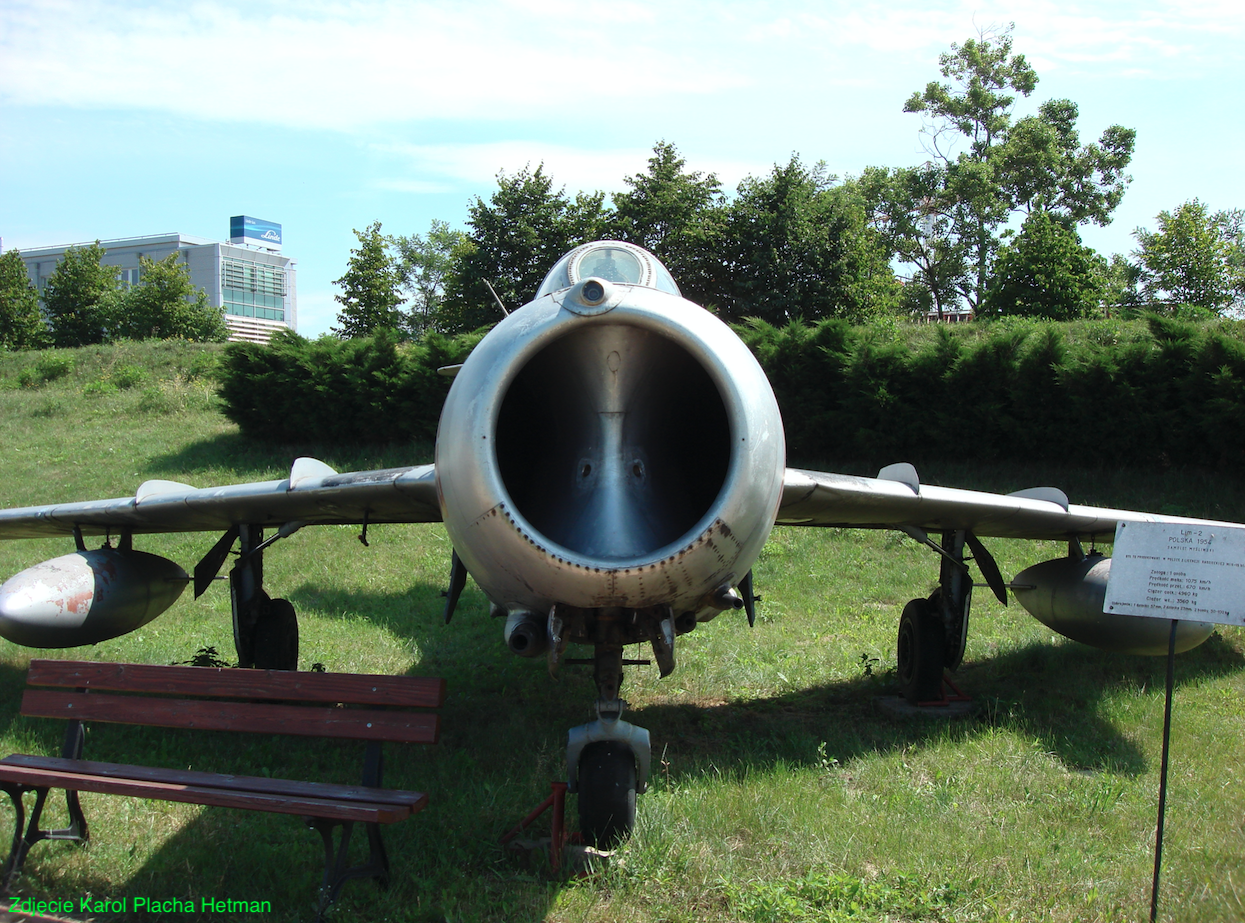
An unfortunate event.
On November 7, 1957, there was another case of desertion of a Polish pilot using the Lim-2 aircraft No. 1B 19-019 / 1919. This time with the 31st PLM in Łask. The pilot of this unit, Lt. Bogdan Kożuchowski, hijacked the plane with board number 1919 to Sweden. It was a time when the communist system was already well prepared to react appropriately to such cases. Action was taken promptly and severely. Of course, for those who stayed in the country. The unit was punished with reorientation of tasks, replacement of equipment and change of structural subordination. The regiment was withdrawn from the structures of the 5th DLM OPL OK. The regiment was subordinated to military education and became the 31st Air Training and Combat Regiment. An indirect effect was also the failure to establish a school regiment in Tomaszów Mazowiecki. The regiment was deprived of Lim-2 aircraft. However, the already exploited MiG-15 was introduced.
Fortunately, this case of desertion was the last in the LWP fighter aviation. At the same time, since 1958, court judgments concerned only escapees. Those responsible - let's call it - morally, were punished with disciplinary punishment, a warning, rarely a transfer to a lower position. Until the end, the prison sentence was accompanied by the deprivation of civil rights, which was painfully felt by the families left in the country.
Let's expand on this to better understand the consequences of subsequent decisions. We would be wrong if we blamed Lieutenant Bogdan Kożuchowski for everything. The mid-1950s was a period of slow but beneficial changes in Poland. Society began to stand up for just rights. One of the greatest criminals in the history of mankind - the communist Joseph Stalin was already dead. In Poznań, the "Poznań Accidents" took place (June 28, 1956), which increased the tension in Poland. It was realized that changes had to take place. The party authorities frantically searched for a way out of the deteriorating situation. From October 19, 1957, the 8th Plenum of the Central Committee of the Polish United Workers' Party was held. One day before the plenum (October 18, 1957), Nikita Khrushchev (communist-tsar in the Kremlin) arrived in Warsaw unexpectedly. The threat of intervention by the Soviet army stationed in Poland became real, and its units began to move towards Warsaw, under the pretext of exercises. The Polish Internal Troops, subordinated to the Committee for Public Security, were preparing for resistance, unlike most of the Polish Army subordinated to Konstanty Rokossowski (the actual commander of the Polish and Soviet Army in Poland). On October 21, 1957, the plenum decided to restore Władysław Gomułka to power and elected him the first secretary of the Central Committee of the Polish United Workers' Party. His election and the announcement of reforms were enthusiastically received by many citizens. Władysław Gomułka promised the Soviets that Poland would never stray from the path of communism. The Russians returned to their barracks. Political prisoners were released. In the Polish Army, a significant part of the Russian cadre received orders to return to the CCCP. Polish officers began to implement their own Polish training plans. Many professional soldiers who fought in the war in the West returned to the army.
In the Military Aviation, attempts were made to raise the level of training, and thus the safety of flights, in order to avoid unnecessary tragedies, catastrophes and accidents as much as possible. The period of training Polish pilots as "cannon fodder" was coming to an end. The focus was on modern and comprehensive training of pilots. In order to achieve these goals, it was necessary to expand the intermediate level between the aviation schools (Dęblin and Radom) and combat units. It was a good idea to establish several training and combat units. No longer a school, and not yet a hundred percent combat regiment. A plan was drawn up and started to be implemented. Two new types of aviation regiments were created; Training Regiments and Combat Training Regiments. The Training and Combat Regiment was to be formed, among others, in Tomaszów Mazowiecki, only 70 km away from Łask, in the eastern direction.
The incident committed by Lieutenant Bogdan Kożuchowski was a good excuse to reduce military spending. Albeit a minor reduction. The Aviation Regiment in Tomaszów Mazowiecki was not created, and the penalty imposed on the 31st PLM in Łask resulted in its degradation to the role of a school unit. Replacing the planes with older and much more worn-out ones was only the aftermath of earlier decisions. Something had to be done with the old planes.
Let us also remember that in the 5th DLM OPL OK, there were three regiments; 1. PLM, 13. PLM and 31. PLM, and wanting to reduce the burden on the Polish budget and at the same time be in accordance with the provisions of the Warsaw Pact and orders from Moscow, divisions were created in the composition of two regiments.
31 Air Training and Combat Regiment. 1958-1963 year.
At the beginning of 1958, the 31st PLM was renamed the 31st Air Training and Combat Regiment. The commander of Lt. Col. pil. Henryk Michałowski remained at his post and rose to the rank of Major General. The regiment functioned in this condition until 1963. We are not entirely sure whether these changes were so severe for the 31st Regiment? Summa summarum, service in Łask became calmer and less stressful. Tasks became less stressful. More attention could have been paid to flight safety. The stock of ammunition and bombs has also been reduced. From 1958, new pilots came to Łask straight from schools in Dęblin and Radom. Here they perfected their skills and performed their first training and combat tasks. The 31st Training and Combat Regiment in the period 1957-1963 trained 162 pilots of turbojet aircraft. In 1963, the new commander of the Regiment was Lt. Col. pil. Janusz Kowalski, who held this position until 1963. (Janusz Kowalski was later, among others, the governor of Siedlce and had the academic title of doctor).
At the end of 1963, the 31st LPSzk-B was disbanded, which does not mean that Ziemia Łaska lost its pilots.
2nd Fighter Aviation Regiment. 1963-1967 year.
At the beginning of the 1960s, the 2nd PLM in Czyżyny, due to its location between two large cities, Krakow and Nowa Huta, began to be a nuisance for a large agglomeration. On the wave of changes in Polish Aviation, the 2nd PLM was transferred from Czyżyny - Rakowice Airport to Łask Airport. This happened under the Order of the Chief of the General Staff No. 062/Org of April 18, 1963.
In May 1963, planes were transferred by air to Łask Airport, and the remaining equipment and personnel were sent to echelons. In Czyżyny, part of the equipment, already significantly exploited, remained, which became the exhibits of the newly established Museum of Aviation and Astronautics. The military used Czyżyny Airport almost until 1970.
You can ask a question - Why was the 2nd PLM not transferred to the Balice Airport, which it occasionally used? A decision was made to locate the new 55th Transport Aviation Regiment at the Balice Airport, which in 1967 was transformed into the 13th Transport Aviation Regiment.
In Łask, the 2nd PLM was a conglomerate of equipment left over from the 31st LPSzk-B and the equipment of the 2nd PLM. It was the same with the professional staff. The commander of the unit in Łask was still Lieutenant Colonel pil. Janusz Kowalski. However, this does not prevent the implementation of the tasks assigned to the regiment.
In 1966, the 2nd PLM (Łask) took part in the great celebrations celebrating the 1000th anniversary of the founding of the Polish State. It should be remembered that on April 14, 966 (in the 10th century), on Holy Saturday, Prince Mieszko I of Poland, together with his subjects, received the Sacrament of Baptism. In this way, Poland entered Latin culture. All aviation regiments participated in many shows. Also 2nd PLM. The culmination was a great air parade over Warsaw on July 22, 1966. July 22 was then a public holiday to celebrate the announcement of the PKWN manifesto. You need to know that the communists did everything to humiliate the church celebrations that took place in Gniezno and Jasna Góra. A military parade consisting of about 1,000 aircraft that formed various, sometimes very complicated formations. The Regiment from Łask, among others, took part in the formation called the herringbone, which was made up of 36 Lim-5 aircraft.
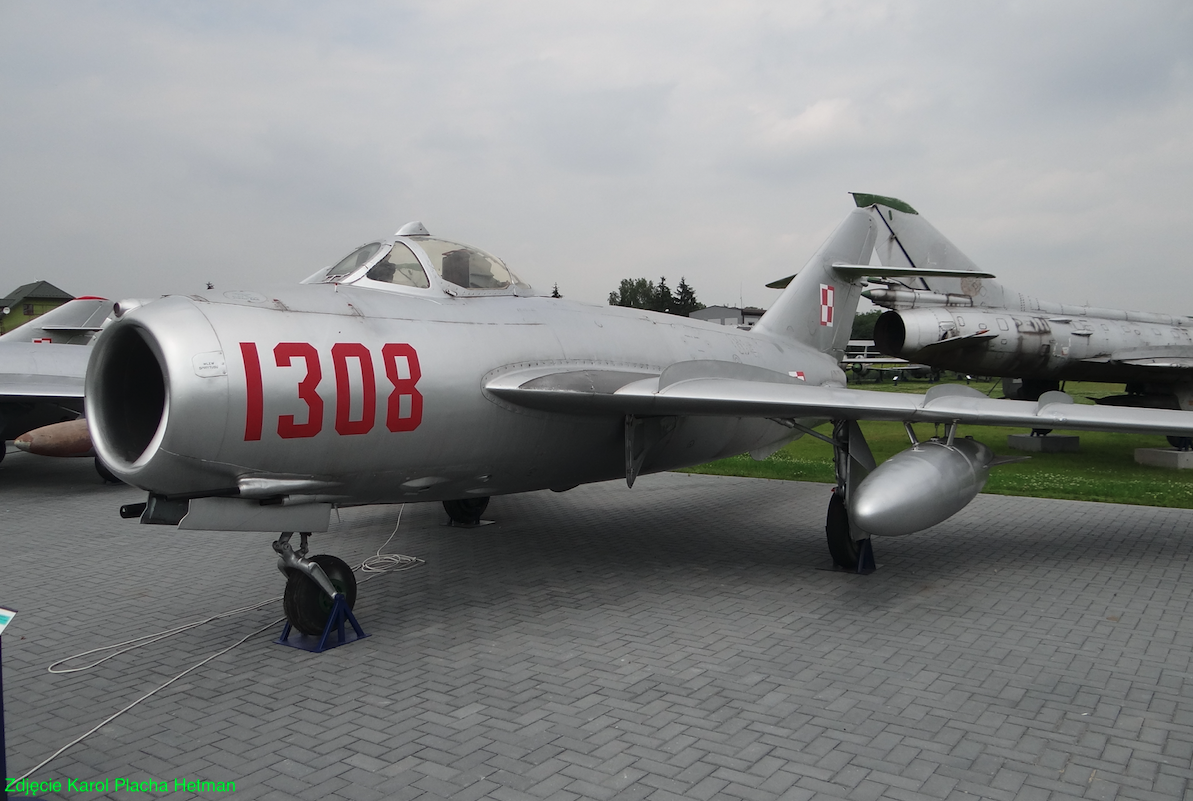
In 1967, there were further changes in Polish Aviation. The 2nd PLM in Łask was disbanded and the 10th PLM was formed in its place. It was a time of deep communism. The rulers wanted to emphasize the Soviet roots of the Polish Aviation Units.
10th Fighter Aviation Regiment. 1967-1999 year.
In 1968, the 10th PLM was fully formed and subordinated to the WOPK Command and was in the structures of the 1st Corps together with the 1st PLM from Mińsk Mazowiecki, the 13th PLM from Łęczyca and the 42nd Air Communications and Transport Squadron.
There is no information on how many and what kind of fighters the 10th PLM in Łask used until the arrival of the first MiG-21 aircraft. They were definitely Lim-2, SB Lim-2, Lim-5 and Lim-5 P fighters. It is known that in nine air regiments in WOPK, five LO regiments and four school regiments in 1970, there were still 257 Lim-2 fighters, 202 Lim-5 fighters, 81 Lim-5 P fighters and 200 training and combat SB Lim-1 / 2. The commander of the 10th PLM was then Lt. Col. Dipl. dj Józef Radon. The later commander of the WLOP, Lt. Gen. pil, Jerzy Gotała, also served in this Regiment.
The real hardware revolution took place in 1968. The regiment began adopting supersonic MiG-21s. The first aircraft (6 copies) of the MiG-21 PF were taken over by the regiment in March 1968 from the 3rd PLM. Another 6 copies of the MiG-21 PF were taken over in April 1968 from the 1st PLM in Mińsk Mazowiecki. Among these 12 machines were; 761506, 761608, 761610, 761614, 761708, 761712. In August 1970, another 10 MiG-21 PF aircraft were accepted. In 1971, another 7 MiG-21 PF aircraft from the 13th PLM and 39th PLM were accepted. In subsequent years, single copies were accepted. In the period from March 1980 to October 1980, 8 MiG-21 PF aircraft from the 39th PLM were accepted. The last MiG-21 PF was accepted into the Regiment on March 9, 1984.
With the MiG-21 PF aircraft, the 10th PLM definitely parted ways in 1989, when several machines were directly deleted at the airport, and the rest were transferred to the BSP (air equipment base) in Mierzęcice.
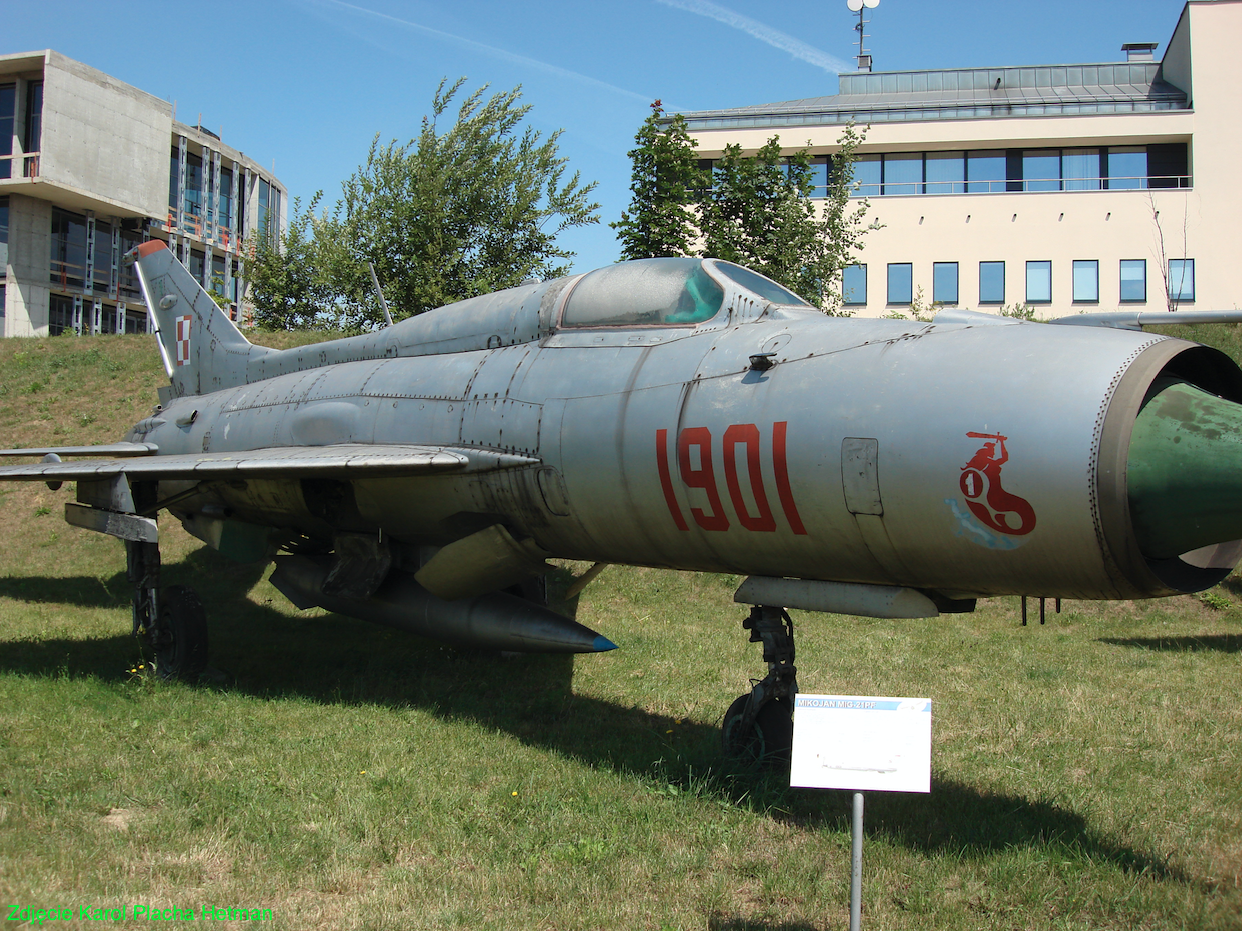
Photo description: The emblem of the 1st PLM Mińsk Mazowiecki is on the fuselage of the aircraft.
The Garrison Club was established in the military housing estate in Łask. Its ceremonial opening took place on October 5, 1968. The club was made available to both soldiers and other inhabitants of Łask. There are, among others: a library, a cinema, a cafe. Organizations and associations cooperating with the army have their headquarters here. Wheel of interest. The club is an important animator of culture, not only in the army.
In 1972, the 13th PLM from Łęczyca left the 1st Corps and was disbanded. The reason for its dismantling was the introduction of numerous helicopters into service, which were also located in Łęczyca.
In 1974, the WOPK fighter aviation was reorganized. It consisted in the transition from a three-squadron structure to a two-squadron structure. Two squadrons were formed in the regiments, each with 18 combat aircraft. It was the right decision. She simplified the training and performance of combat tasks. It also reduced the burden on the national budget.
From 1972, Polish Military Aviation began to accept supersonic MiG-21 MF fighters. In the 10th PLM in Łask, the MiG-21 MF and MiG-21 UM aircraft arrived relatively late. Training for the new type was carried out on the basis of equipment from the 28th PLM and 34th PLM from which aircraft were temporarily rented; 10 MiG-21 MF aircraft and 2 MiG-21 UM aircraft. This was between February and May 1978. The Regiment in Łask had to wait for its own planes until 1981, when 20 MiG-21 MF planes were received from the 26th PLM from Zegrze Pomorskie. (The 26th PLM in Zgierz Pomorski received new MiG-21 bis aircraft). These were mainly planes produced at the Gorki plant. The 10th PLM operated these machines until 1989, when it handed them over to the 11th PLM in Wrocław. In place of the MiG-21 PF, the MiG-21 MF was introduced from the dismantled 2nd PLM Kraków in Goleniów, as well as from the 41st PLM from Malbork.
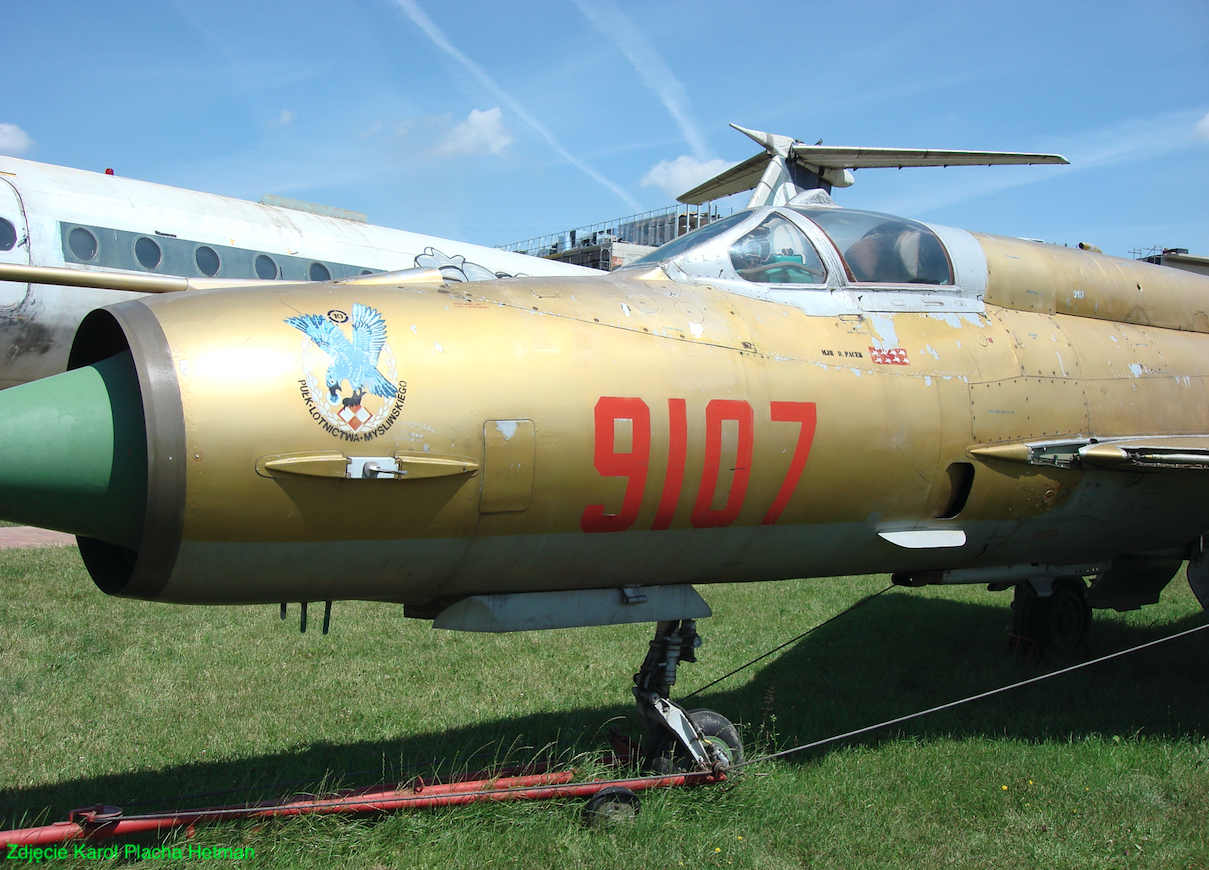
Photo description: The emblem of the 10th PLM in Łask is visible on the fuselage of the aircraft. The aircraft was operated at the airport in Łask.
The next version of the MiG-21 aircraft was the MiG-21 M, and although these machines have been in Poland since 1969, they were delivered to Łask only in 1985. In August and September 1985, two MiG-21 M aircraft No. 96 A 1901, 96 A 1913, which previously served in the 26th PLM, were delivered to the 10th PLM.
In 1986, the emblem of the 10th PLM and the 1st Squadron appeared on the MiG-21 PF aircraft. The emblem was designed by Senior Staff Warrant Officer Wiesław Turowiecki in April 1986. Its symbolism refers to its predecessor, i.e. the 2nd PLM and its times of stationing at the Czyżyny Airport in Krakow. It depicts the black Wawel dragon wearing a krakowiak cap. In his left hand, the dragon holds a shield in the form of a white and red chessboard with the coat of arms of the City of Łask. He shoots a red lightning bolt from his right hand. The emblem was approved by the then commander of the 10th PLM, colonel, certified pilot Władysław Dąbkowski. From that moment it was placed on the hull, on both sides between the air grip and the side number. After a few years, it went to the top of the vertical tail. It must be remembered that this emblem was one of the first ones painted on MiG-21 aircraft.
Anticipating the facts, we still have to write about the next emblem of the 10th PLM. In 1993, there is a change of symbols in the Polish Army. Among other things, the sign of the Polish Military Aviation - the White and Red Chessboard is changed to colors consistent with heraldry. And it was right. However, unfortunately for some reason, a completely new sign was developed for the 10th PLM. It depicts a silver eagle against a golden laurel wreath, with a chessboard and a laurel wreath in its beak. At the top, another laurel wreath with the number 10. The sign became the emblem of the 10th PLM. The 1st Squadron painted the Wawel Dragon. The 2nd Squadron adopted a new symbol: a stylized eagle in a krakowiak cap.
Although the MiG-21 PFM aircraft have been used in Poland since 1966, they came to the 10th PLM relatively late. MiG-21 PFM aircraft to the 10th PLM arrived on December 23, 1987. The first two were No. 94 A 4013, 94 A 4203. The next year (1988) another MiG-21 PFM was incorporated, a total of 17 aircraft. The next 7 machines were received in February 1988, also from the 62nd PLM. Another was delivered from the 39th PLM. In 1989, the Regiment inherited another 20 fighters from the 2nd PLM Goleniów, including 3 MiG-21 PFM type 94 N machines, no. 94 N 7810, 94 N 7811, 94 N 7812. MiG-21 PFM aircraft were withdrawn from service in Poland in 1997.
In the period 1989 - 1990, Łask Airport became the scene of the scrapping of several MiG-21 PF machines to demonstrate to the free world the unilateral reduction of armaments and Polish non-aggressive intentions. In accordance with the unilateral action plan of the Ministry of National Defense of the Republic of Poland, aimed at reducing the military potential and the level of expenditure on armaments. On January 15, 1990, several journalists and photojournalists were invited to the premises of the 10th Fighter Aviation Regiment of the National Air Defense. They immortalized the process of permanent destruction of the aircraft in pictures.
In 1991, the 10th PLM was in stock; 22 MiG-21 PFM / M / MF fighters and 5 training and combat MiG-21 UM. In the period 1991 - 1996, the 10th PLM in Łask took over almost half of the MiG-21 MFs still in use.
Since 1996, the 10th PLM has been assigned to the structures of the 3rd KOP (air defense corps). In August 1998, the command of the air force decided to rotate the MiG-21 aircraft remaining in service. In October 1998, the 3rd PLM (ex 62 PLM) in Krzesiny received MiG-21 MF aircraft from the 41st PLM in Malbork. So for the second time the MiG-21 MF came to Krzesiny.
In 1999, the 11th PLM from Wrocław was disbanded. All its operational MiG-21 MF aircraft were transferred to the 3rd PLM and 10th PLM in Łask. Thanks to this, all MiG-21 MF still in use were concentrated in these two regiments.
It should be remembered that the basic type of fighter used for 35 years in the 10th PLM was the MiG-21 in the PF, PFM, M, MF, U, UM versions, i.e. 6 versions out of 10 that Poland bought. The 10th PLM also used PZL TS-11 Iskra training and training aircraft.
The unit in Łask has raised many pilots over the years, who won the highest aviation laurels in its composition, and the Regiment itself was awarded many times. The soldiers of the Regiment have always been characterized by patriotism. This is evidenced by the blood sacrifice of 16 pilots who died the death of an airman during training.
In 1994, on the 50th anniversary of its formation, the unit received a banner of a new pattern funded by the community of Łask. Poland's entry into the structures of the Atlantic Pact changed Poland's defense doctrine, as a result of which a new structure of the armed forces was created.
The last day of service of the 10th PLM was December 31, 2000, in its place the 32nd Air Base and the 10th Tactical Aviation Squadron were established.
Regiment commanders:
Major Pil. Michał Kożewnikov 1944-1945 (Soviet). Lt. Col. pil. Vasyl Bystrov 1946 (Soviet). Lt. Col. pil. Edward Chromy 1947-1951 (later Commander of ITWL, among others). Lt. Col. pilot Tadeusz Olędzki 1951-1953. Lt. Col. pil. Andrzej Rybacki 1953-1954 (In 1950, he was one of the first pilots trained on turbojet aircraft, later, among others, the commander of the 2nd KOP. Brig. Gen.). Lt. Col. pilot Henryk Rzemienicki 1955-1961. Lt. Col. pilot Albin Daniłowicz 1961-1963 (later, among others, head of the CSD). Lieutenant Colonel pilot Janusz Kowalski 1963-1966 (later, among others, the governor of Siedlce). Lieutenant Colonel pilot Józef Radoń 1966-1972. Lieutenant Colonel Maciej Brzeziński 1972-1978 (later commander of the 2nd Air Traffic Management Centre). Lieutenant Colonel pilot Zbigniew Dubiński 1978-1980 (later he worked, among others, in the CSD). Colonel pilot Władysław Dąbkowski 1980-1985 (later he worked in WLOP). Lieutenant Colonel Marek Ciszewski 1986-1989 (later Permanent Representative of the Republic of Poland to NADC). Lt. Col. pil. Stanisław Kohden 1989-1992 (later worked at WLOP). Lt. Col. pilot Waldemar Stajniak 1992-1997 (later he worked in WLOP). Major pilot Jan Śliwka 1997-1999 (later in the 2nd BLT)). Major pilot Dariusz Pacek 1999-2000 (later commander of the 32nd Air Base).
MiG-21 fighter planes in Łask.
The basic type of fighter used in Łask was the MiG-21. Below we present planes that were definitely used in the 10th PLM in Łask.
MiG-21 PF: nb 1506 / 761506, nb 1608 / 761608, nb 1610 / 761610, nb 1614 / 761614, nb 1708 / 761708, nb 1712 / 761712. A total of 6 aircraft.
MiG-21 PFM: nb 4013 / 94 A 4013, nb 4106 / 94 A 4106, nb 4203 / 94 A 4203, nb 7810 / 94 N 7810, nb 7811 / 94 N 7812, nb 7812 / 94 N 7812, nb 07 02 / 94 A 0702. 7 aircraft in total.
MiG-21 M: nb 1810 / 961810, nb 1901 / 961901, nb 1913 / 961913. 3 planes in total.
MiG-21 MF: nb 6804 / 966804, nb 7809 / 967809, nb 7907 / 967907, nb 7913 / 967913, nb 9010 / 969010, nb 9011 / 969011, nb 9107 / 969107. Total 7 aircraft.
MiG-21 UM: nb 9311 / 516999311.
24 aircraft are known. MiG-21 aircraft ended their service in Łask in January 2003. Most of them were temporarily stored at Łask Airport.
Attempts to locate civil aviation at Łask Airport.
Attempts to locate civil aviation at Łask Airport lasted from the mid-1990s. Due to the fact that in the Łódź agglomeration there was no airport capable of accepting passenger planes requiring a runway length of 2,500 meters, attempts were made to use Łask Airport for military purposes for civilian purposes. In this way, a plan was developed to expand the airport and create an airport for central Poland in Łask, serving Łódź, Piotrków Trybunalski, Bełchatów, Sieradz, Turek, and Zduńska Wola.
The Office of Airport Studies and Projects has defined traffic forecasts for the airport in Łask. According to these forecasts, in 2010, 150,000 to 200,000 passengers could be served here annually, and in 2030 - 500,000. The idea of adapting this airport to passenger traffic was dealt with by the "Łódź Airport" company, which existed since 1998. However, due to the expansion of the Łódź Władysław Reymont airport, where the runway (RWY) was extended to 2,500 meters, terminal 2 was built and a terminal 3 is planned. stop completely. In addition, the F-16 Jastrząb multi-role aircraft, stationed since 2008, could not coexist with commercial aviation. Łask airport cannot be civil-military. The Łask Airport company has been dissolved.
On the area of 68 square km, in approximately 32. BLot, from 2010, it is not possible to invest in, for example, recreational facilities, and the existing residents will be able to apply for compensation. All because of the noise emitted by the 16 F-16 machines stationed here. This was decided by the councillors. We have already written about the noise in Krzesiny many times. In Łask, the situation was repeated. Interestingly, when the Local Authorities tried to open Łask Airport as a civil-military one, the noise did not bother them. But when the company Łask Airport was liquidated (the Polish Army did not want to share the facility), more creative people got wind of another business. Most of these people were not bothered by the noise of more than thirty MiG-21 fighters from 1968 to 2003.
Written by Karol Placha Hetman
